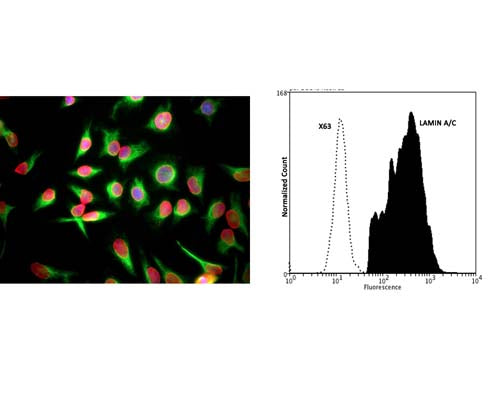Anti-Lamin A/C Antibody (4C4)
Our Anti-Lamin A/C mouse monoclonal primary antibody detects human Lamin A/C, and is IgG. It is validated for use in FC, ICC, WB.

![Left: Lamin A/C expression in HeLa cells, stained with mouse antibody to lamin A/C (red, 1:2,000) by Immunocytochemistry. Co-staining was performed with a rabbit anti-HSP60 antibody (green). Blue: Hoechst nuclear stain. The lamin A/C antibody specifically labels the nuclear lamina. Right: Western blot analysis of lamin A/C expression in cell lysates using mouse anti-lamin A/C antibody (green, 1:1,000). [1] protein standard, [2] HeLa, [3] HEK293 [4] C6, and [5] NIH-3T3 cell lysates. Two strong bands at 74 and 65 kDa correspond to the lamin A and lamin C proteins, respectively, detected only in the cells of human origin. The lamin A/C antibody does not recognize rat or mouse proteins.](http://www.antibodiesinc.com/cdn/shop/files/m-1689-100-ihc-wb_120x120.jpg?v=1759273386)
Left: HeLa cells stained with M-1689-100 (red), and counterstained with chicken polyclonal antibody to Vimentin (green, C-1409-50). The The Lamin A/C antibody reveals strong nuclear lamina staining, while the Vimentin antibody reveals cytoplasmic intermediate filaments. The blue stain reveals DNA in the nuclei of these cells. Right: Analysis of Lamin A/C expression in human prostate cancer DU145 cell line by FLow Cytometry. Fixing and Permeabilization of cells: Absolute methanol (10 minutes in ice) and 0.1% Tween-20 in PBS, Blocking: 200 µg/mL Normal Sheep IgG (20 minutes), Primary antibody: Mouse Monoclonal antibody to Lamin A/C (cat # M-1689-100, 2 μg per ~10^6 cells) for 30 minutes at room temperature, Secondary antibody: Goat anti-mouse PE labeled secondary antibody (1:100 fold dilution) with incubation for 20 minutes in dark at room temperature. Non-specific Control IgG, clone X63 (cat # M-1249-100) was used as negative control under same conditions (black dashed). Flow cytometry data and results were generated using Orflo MoxiflowTM instrument and protocols.
Click on image to zoom
SKU: M-1689-100
Ships: 1-2 business days
Product Details
Lamin A/C
The Lamin proteins are members of the intermediate filament protein family but are located inside the nucleus rather than in the cytoplasm (1). The lamins function as skeletal components tightly associated with the inner nuclear membrane. Originally the proteins of the nuclear cytoskeleton were named Lamin A, B and C, from top to bottom as visualized on SDS-PAGE gels. Subsequently it was found that Lamins A and C were coded for by a single gene (2), while the Lamin B band may contain two proteins encoded by two genes now called Lamin B1 and Lamin B2. Lamin A has a mass of about 74 kDa while Lamin C is 65 kDa. The Lamin A protein includes 98 amino acids missing from Lamin C, while Lamin C has a C-terminal 6 amino acid peptide not present in Lamin A. Apart from these regions Lamin A and C are identical so that antibodies raised against either protein are likely to cross react with the other, as is the case with this monoclonal. Lamin polymerization and depolymerization is regulated by phosphorylation by cyclin dependent protein kinase 1 (CDK1), the key component of "maturation promoting factor", the central regulator of cell division. Activity of this kinase increases during cell division and is responsible for the breakdown of the nuclear lamina. Mutations in the LMNA gene are associated with several serious human diseases, including Emery-Dreifuss muscular dystrophy, familial partial lipodystrophy, limb girdle muscular dystrophy, dilated cardiomyopathy, Charcot-Marie-Tooth disease type 2B1, and Hutchinson-Gilford progeria syndrome. This family of diseases belong to a larger group which are often referred to as Laminopathies, though some laminopathies are associated in defects in Lamin B1, B2 or one or other of the numerous nuclear lamina binding proteins. A truncated version of lamin A, commonly known as progerin, causes Hutchinson-Gilford progeria syndrome, a form of premature aging (3).
IgG
Monoclonal
4C4
IgG1
Flow, ICC, WB
Mouse
Full length recombinant human Lamin C
Human
Human
Spin vial briefly before opening. Reconstitute with 100 µL sterile-filtered, ultrapure water to achieve a 1 mg/mL concentration. Centrifuge to remove any insoluble material. After reconstitution of lyophilized antibody, aliquot and store at -20°C for a higher stability. Avoid freeze-thaw cycles.
Lyophilized
Protein G purified
Lyophilized from PBS buffer pH 7.2-7.6 with 5% trehalose, and sodium azide
WB: 1:1000-1:2000
ICC: 1:500-1:1000
ICC: 1:500-1:1000
Use 2 ug/10^6 cells for Flow cytometry.
Unconjugated
Does not react with mouse and rat.
For research use only.
United States
12 months after date of receipt (unopened vial).
25°C (ambient)


